|
I
found this a refreshing high quality release from Dragon (DML). Models
of Japanese AFVs, when compared with German, US and Soviet AFVs, have
been relatively rare. The only ones I know of that are available in
small scale is the old Airfix Type 97 kit and some resin kits. Now
DML has released variants of the Japanese Type 97 medium and the Type
95 light tanks.
A
Wee Bit Of History For The Modeler
Introduced in 1930, this tank was classified as a medium tank but
by 1944 it fit more into the light tank classification.
The Type 97 “Chi Ha” (along with the later “Shin
Hoto” version) was the main battle tank of the Imperial Japanese
Army. My references show it served in the battles for China, Malaya
in 1941, Guadalcanal in 1942, Philippines in 1942 and 1945, Saipan
in 1944, Iwo Jima in 1945, and Manchuria in 1939 and 1945, and was
stationed on the home islands in 1945.
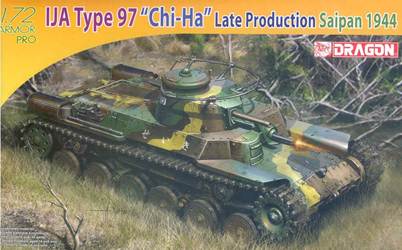
Looking at the box art, let us see what is supposed to be inside
the box. Here we see the Type 97 in combat, I presume to represent
Saipan Island, 1944, based on the box title. - On
the low turret we see a commander’s cupola and a round frame
antenna on brackets around the turret. This tank could also be modeled
without the frame antenna.
- The
gun mount is for a 57-mm low-velocity main gun. There is a 7.7-mm
machine gun protruding from the rear of the turret rather than coaxial
with the main gun. The turret and hull are of riveted construction,
not welded, as was common to other nation’s tanks in 1944.
- On
the upper hull we see several hatches on the bow, which may be for
servicing the brakes or transmission, or could also be used for
emergency escape hatches for the driver and hull machine gunner.
There is a roof hatch over the hull machine gunner position, but
no roof hatch for the driver.
- There
are six rubber tired roadwheels (per side) and a sprocket wheel
at the front.
- The
tank is painted in a commonly seen three-color camouflage of green,
brown and pale yellow. On the turret and hull side are white vehicle
and unit markings.
-
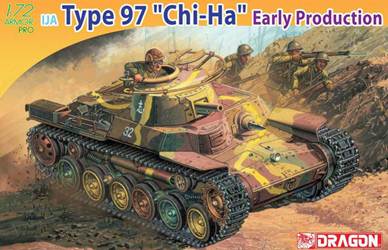
This Dragon Early Production Chi-Ha kit 7395 represents what
is stated as an early production Chi-H tank. The major difference
evident to me is a slightly different engine deck. The turret, suspension
and front hull appear the same. This hull variant appears to match
the Airfix Chi Ha kit.
- A
commander figure and three infantry are portrayed in the painting,
but no figures are included within the model kit.
- Except
for the upper hull (part-B) and the decal markings, this kit is
the same as Dragon kit 7397, so assessment of this model kit should
be pretty much the same as for kit 7397, the Late Production "Chi-Ha".
- Markings
included are for a tank in Malaya in 1941, and one in Manchuria
in 1945.
The
Kit Parts
Dragon gives us 53 light gray, injection molded, styrene plastic parts
on one main sprue (sprue A), lower and upper hulls on Sprue B and
Sprue C. There are two light tan color DS plastic band tracks, and
a small etched brass fret MA with screens for the two fender-mounted
mufflers.
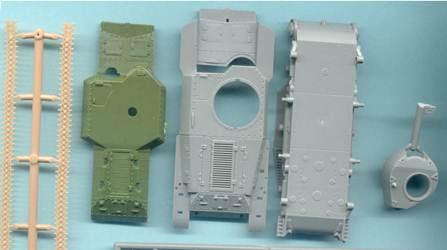
At far left are the two Dragon kit band-tracks in tan DS plastic,
which appear well detailed on both sides.- To
the left is the green Type 97 tank upper hull from the veteran 1/76-scale
Airfix Models kit next to the pale gray DML Type 97 hull for comparison.
Taking into account the scale difference and that the Airfix is
missing some hull parts, we can note subtle differences in shape
of the machine gunner’s hatch, the engine deck grate, and
rivet detail. The Airfix kit appears to be similar to the Dragon
kit 7395, representing an early production Type 97 Chi-Ha .
- Unfortunately
the hull hatch is molded closed and there are no crew figures.
- At
right is the slide molded hull bottom and sides with suspension
components mounted onto the hull.
- At
far right is the teardrop-shaped turret with open cupola hatch and
mounting points for the frame antenna.
-
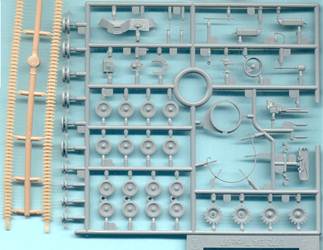
In this scan we see at left that the four return rollers, four
of the 12 roadwheels and the two idler wheels are slide molded as
pairs. At lower left are four pair of roadwheels mounted on suspension
arms.
- At
top left is a nicely rendered front plate with the driver’s
viewport (molded closed) and the hull machinegun mount.
- At
right are various parts such as the delicate frame radio antenna,
the 57-mm gun, separately molded shovel, etc.
- At
top right are the two engine mufflers (parts A16 and A17) that mount
on the rear mudguards (fenders).
-
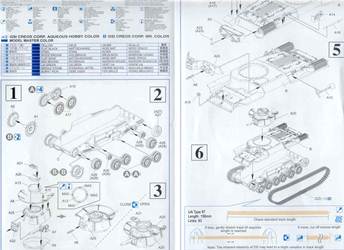
The kit assembly instructions are the standard exploded-view
type broken into six steps. Each part is numbered and special instructions
are coded so as to be understood by multiple nationalities. Instructions
look clear. (Like with any kit and instructions, eventual assembly
may reveal some problems.)
- At
lower right are instructions for stretching the band track if necessary.
(Some of my Dragon band tracks I’ve used have needed stretching
and some not.)
-

On the back of the kit 7395 instruction sheet is multi-color
painting and marking guide for only one Chi Ha tank of the 9th Tank
Regiment, Saipan 1944. Considering the long and widespread service
of this AFV I feel it is a shame that additional markings for other
tanks are not included.
- At
lower right are the water slide decal markings. Above right is the
small etched brass fret for the muffler protective screens.
- Notice
how the turret is offset to the starboard (right) side.
- On
of the front of the instruction sheet, but not shown here, is a
parts diagram standard for DML kits.
CONCLUSIONS
- In
the box the kit appears to be an accurate and very well molded and
detailed. Another nice release of an uncommonly modeled AFV.
- Though
not released at this time, I presume and hope that Dragon will also
be releasing a kit of the Type 97 “Shin Hoto” version
with the high velocity 47-mm gun; they only need to replace the
turret. Self propelled artillery versions using this tank chassis,
such as the Type 1 “Ho Ni” and Type 1 “Ho Ro”
would also be very welcome, please.
REFERENCES
- Tank
Warfare On Iwo Jima, by David Harper, Squadron Signal Publications
(2008). ISBN978-0-89747-559-4
- Tank
Battles of the Pacific War 1941-1945, Armor At War Series 7004,
by Steven J. Zaloga, Concord Publications Co. (1995) ISBN 962-361-607-4
- Taki
Imperial Japanese Army website
- Henk
of Holland’s website
(A Henk of a good small scale model reference site. ? )
|